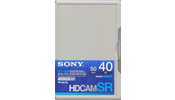HDCAM SR
HDCAM SR was introduced in 2003 and standardised in SMPTE 409M-2005. It uses a higher particle density tape and is capable of recording in 10 bits 4:2:2 or 4:4:4 RGB with a video bitrate of 440 Mbit/s, and a total data rate of approx. 600 Mbit/s.[2] The increased bitrate (over HDCAM) allows HDCAM SR to capture much more of the full bandwidth of the HDSDI signal (1920×1080). Some HDCAM SR VTRs can also use a 2x mode with an even higher video bitrate of 880 Mbit/s, allowing for a single 4:4:4 stream at a lower compression or two 4:2:2 video streams simultaneously. HDCAM SR uses MPEG-4 Part 2 Simple Studio Profile[1] for compression, and expands the number of audio channels up to 12 at 48 kHz/24-bit.
There are 12 channels of audio recorded uncompressed at 24bit 48 kHz sampling. Each channel is capable of recording AES3 non-audio data.
HDCAM SR is used commonly for HDTV television production. As of 2007, many prime-time network television shows use HDCAM SR as a master recording medium.
Some HDCAM VTRs play back older Betacam variants, for example, the Sony SRW-5500 HDCAM SR recorder, plays back and records HDCAM and HDCAM SR tapes and with optional hardware also plays and upconverts Digital Betacam tapes to HD format. Tape lengths are the same as for Digital Betacam, up to 40 minutes for S and 124 minutes for L tapes. In 24p mode the runtime increases to 50 and 155 minutes, respectively.
HDCAM tapes are black with an orange lid, and HDCAM SR tapes black with a cyan lid.
440 Mbit/s mode is known as SQ, and 880 Mbit/s mode is known as HQ, and this mode has recently become available in studio models (eg. SRW-5800) as well as portable models previously available. In 2008 the SRW-5800 will give the “HQ” 4:4:4 option.
Sony has also announced a higher compression mode called “SR Lite”. As with the 440 and 880 mode, SR Lite utilizes the MPEG-4 Part 2 Simple Studio Profile but decreases the bitrate down to 220 Mbit/s for 60i and 183 Mbit/s for 50i. SR Lite is locked at 4:2:2 color sampling but still maintains at 10 bit pixel depth. It also allows for 50 and 60p at the cost of a doubled data rate (440 Mbit/s for 60p).
